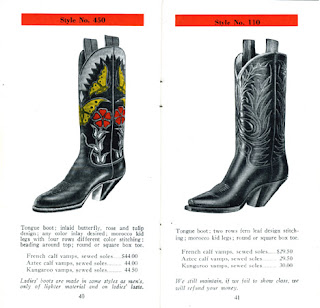Cowboy boots are a uniquely American art form... but their "look" owes much to 19th century European culture and German shoemaking. Shoemaking was a valued and respected art in Europe. The shoemaker apprenticeship program taught young men the art of cordwainery and the craft of cobbling.
cordwainer:
"shoemaker, leatherworker," c.1100, from Anglo-Fr. cordewaner, from O.Fr. cordoan "(leather) of Cordova," the town in Spain whose leather was favored by the upper class for shoes.
Many cowboy bootmakers were of German heritage. The Hyer brothers were first-generation Americans. Their parents were German immigrants. Charles and Edward learned shoe making from their father, William, who had worked as a shoemaker since coming to America. G.C. Blucher was Austrian. J.C. Teitzel and C.C. Dehner were of German ancestry.

The Art of C.H. Hyer
The boots worn by the trail-riding cowboys were derived from two popular European military boot styles, the Wellington and the Hessian.
Wellington boots gained popularity in England when men started wearing trousers rather than tight britches. Usually worn under the pant leg, Wellington boots had below-the-knee tops with side seams, straight stacked heels, square toes and cloth tape pull-on straps. The tops were cut straight across or curved slightly higher in front and frequently had stitching around their top edge.

19
th Century Hessian style Military Boots
Hessian boots, also known as Austrian boots, were named for the German city state of Hesse. Worn by Hessian troops in the Revolutionary War and similar to Wellington boots, Hessian boots are distinguished mainly by a V-cut in the center of the top. Large tassels were often hung from the center of the V-cut. Distinctive and fashionable, Hessian boots were popularized by German dandies in late 18th century England. The tasseled short boots worn by Drum Majorettes continue this tradition today.

C.H.
Hyer
Charles Hyer is often credited with inventing the first distinctive cowboy boot in the mid 1870s. The story goes that a cowboy from Colorado or Texas stopped at the Hyer Brothers shop in Olathe, Kansas in 1875 or '76. The cowboy was wearing Civil War era Calvary boots and he wanted a pair of boots with a pointed toe that would slide easily into his stirrup. The boots had to have high, slanted heels that would hold his stirrup on a bucking horse and the cowboy wanted high tops with scallops in the front and back.
 Hyer
Hyer Brothers,
Olathe, Kansas. ca. 1875
Charles made that cowboy a pair of boots just like he wanted. Other cowboys saw and admired Hyer's handiwork and orders started coming into the shop. Hyer was one of the first boot makers to use a self-measuring kit and mail orders to grow his business. Before long C.H. was running a boot-making factory that employed scores of highly skilled workers, most were from Austria, Germany, Poland and Hungary.

1930s Mail-Order
Hyer Cowboy Boots
In their heyday, Hyer was the leading cowboy boot company in America, G.C. Blucher did the best custom work and Teitzel-Jones made the best military boots. Given that the cowboy boot was derived from a military boot, it is not surprising that Hyer also made boots for the military. Hyer and Teitzel-Jones had sales reps, known as fitters, who would travel from military post to military post making measurements and taking orders from Calvary officers for their boots. Hyer and Teitzel-Jones quickly became the major boot suppliers to the military.
 Teitzel
Teitzel-Jones Boot Company
Military boots were J.C. Teitzel's main business. He started making boots in 1875 and he made boots for numerous high ranking U.S. Cavalry officers. His shop was adjacent to Fort Riley, home of the largest, and the last, horse cavalry units in the country. In 1916 Teitzel moved his shop to Wichita, Kansas where he joined forces with Schuyler Jones. Teitzel's partner, C.C. Dehner, chose to stay in Ft. Riley. The Dehner Company, now located in Omaha, Nebraska continues to make fine Riding boots and boots for the military and law enforcement agencies the world over.

The Art of J.C.
Teitzel
Schuyler Jones assumed full ownership of the company in 1930 and Teitzel-Jones continued to make boots for the U.S. military until the horse cavalry was phased out in WWII. They also made some of the finest cowboy boots around. Master boot maker Carl McDowell got his start by working as a handyman at Teitzel-Jones in 1933. When he left to open his own shop in 1946 he was the bottoming room foreman.
 Carl McDowell (l.) with some of his boots. ca. 1950
Carl McDowell (l.) with some of his boots. ca. 1950
The Hyer Boot Company closed in 1977, ending a century-old family tradition of making premium quality Western boots. The Ben Miller Boot Company in El Paso owns the rights to their name.
Teitzel-Jones closed in 1950 after 75 years of making some of the best riding and cowboy boots you could buy.
Carl McDowell died in May, 2005. He was 93 years old. He was a master bootmaker and loved what he did.
The Blucher Boot Co. is still alive and kicking doing what they've always done.
The C.H. Hyer 1930s Mail-Order Cowboy Boots are available for sale.
Please contact me for details.

 Carl McDowell (l.) with some of his boots. ca. 1950
Carl McDowell (l.) with some of his boots. ca. 1950












































